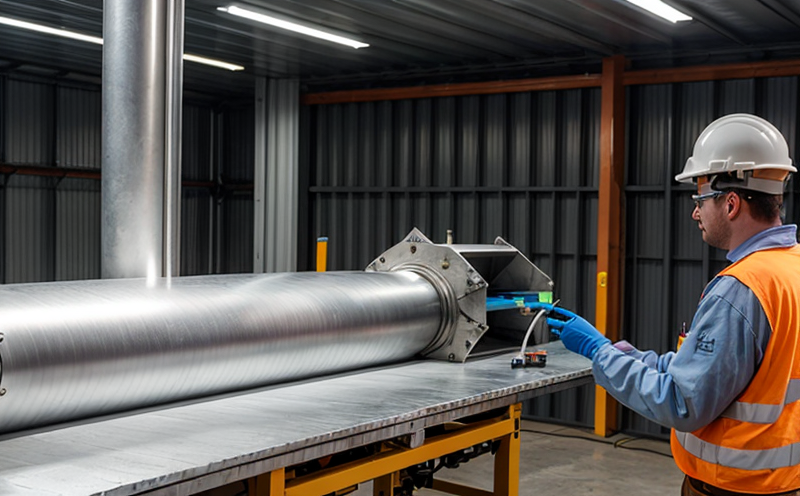ISO 9227 Salt Spray Corrosion Testing of Renewable Components
The ISO 9227 salt spray test is a critical method used in evaluating the resistance to corrosion of materials and components that are exposed to marine environments. This testing procedure simulates the corrosive effects of salt fog, which can be particularly challenging for renewable energy applications such as wind turbines, solar panels, and offshore structures.
The primary goal of this test is to assess the durability and longevity of materials used in the construction of renewable energy devices that are subjected to harsh marine environments. Salt spray corrosion testing helps manufacturers ensure their products meet stringent quality and safety standards before being deployed in real-world conditions. By conducting ISO 9227 tests, companies can identify potential weaknesses early on, reducing the risk of premature failure or costly repairs.
The test involves exposing specimens to a controlled environment where they are sprayed with a saline solution under specific temperature, humidity, and pressure parameters. The duration of exposure varies depending on the type of material being tested and the desired outcome. After the specified period, the samples undergo visual inspection for signs of corrosion such as pitting, rusting, or other surface alterations.
Understanding the intricacies involved in this testing process is crucial for quality managers, compliance officers, R&D engineers, and procurement teams who deal with renewable energy materials. This knowledge ensures that they select appropriate test methods tailored to their specific needs while adhering to international standards like ISO 9227.
| Parameter | Description |
|---|---|
| Temperature Range | 35°C ± 2°C (Typical) |
| Humidity Level | 90% Relative Humidity ± 1% RH |
| Salt Concentration | 5% NaCl Solution |
| Duration Options | 24 hours to 7 days or more depending on the material |
The testing process begins with careful preparation of the specimens. This includes cleaning, degreasing, and ensuring that any protective coatings are intact prior to exposure. During the test, continuous monitoring is essential to maintain precise control over environmental conditions.
After completion, thorough analysis follows where technicians evaluate changes in appearance and performance characteristics. These findings provide valuable insights into how effectively a particular material resists corrosion under simulated marine conditions. Armed with this information, manufacturers can make informed decisions about design improvements or sourcing alternatives if necessary.
In summary, ISO 9227 salt spray testing plays an indispensable role in safeguarding the integrity and reliability of renewable energy components operating in challenging environments. It serves as both a preventive measure against costly failures and a means to enhance overall product quality through rigorous evaluation practices.
Industry Applications
- Wind Turbine Blades: Ensuring that these large structures withstand harsh weather conditions including salt-laden winds.
- Solar Panels: Protecting photovoltaic cells from degradation due to exposure to salty air and rain.
- Offshore Structures: Testing steel supports and other materials used in platforms supporting wind turbines or oil rigs.
- Marine Renewable Devices: Assessing equipment designed to harness tidal currents or wave energy.
| Component Type | Main Concerns |
|---|---|
| Wind Turbine Blades | Rapid deterioration leading to structural integrity issues |
| Solar Panels | Precipitation-induced short circuits and reduced efficiency |
| Offshore Structures | Increased maintenance costs due to corrosion |
| Marine Renewable Devices | Functional failure compromising energy output |
The importance of ISO 9227 salt spray testing cannot be overstated, especially within the context of renewable energy where environmental factors play a significant role in determining product performance and longevity. By adhering to this standard, manufacturers can enhance their reputation for producing high-quality products that meet regulatory requirements while also improving customer satisfaction.
Eurolab Advantages
At Eurolab, we offer comprehensive ISO 9227 salt spray corrosion testing services with a focus on delivering accurate results and reliable data. Our state-of-the-art facilities are equipped to handle various sample sizes and configurations, ensuring consistent test conditions across all submissions.
- Certified Laboratories: All our laboratories comply with international standards including ISO/IEC 17025 for proficiency in testing.
- Experienced Technicians: Our team comprises highly skilled professionals who possess extensive experience in performing salt spray tests according to industry best practices.
- Custom Solutions: We understand that every client has unique requirements; therefore, we tailor our services to meet those needs without compromising on quality or accuracy.
- Compliance Support: Our experts can guide clients through the entire process from initial consultation right up until final reporting ensuring full compliance with relevant regulations and guidelines.
Choosing Eurolab means accessing unparalleled expertise in salt spray testing for renewable energy components. We pride ourselves on providing not just tests but also valuable insights that drive innovation and improvement within our clients' organizations.
International Acceptance and Recognition
The ISO 9227 standard has gained widespread acceptance across numerous countries around the world. It is widely recognized as one of the most effective methods for assessing salt spray corrosion resistance, making it mandatory or preferred in many regulatory frameworks governing renewable energy technologies.
Many global organizations have adopted this standard due to its robustness and reliability. For instance, regulatory bodies such as the American Society for Testing and Materials (ASTM), European Committee for Standardization (CEN), and International Electrotechnical Commission (IEC) all recommend or require adherence to ISO 9227 when evaluating corrosion resistance in materials used within renewable energy sectors.
By incorporating this standard into their quality assurance processes, companies demonstrate their commitment to maintaining high standards of product integrity and reliability. This not only enhances brand reputation but also fosters trust among stakeholders including investors, end-users, and regulatory authorities.





